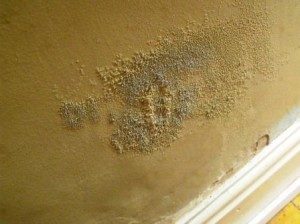The Effect of Damp on Painted Surfaces
There are many reasons for dampness on painted surfaces of our homes; some of these are structural and others due to moisture that somehow penetrates the house, often resulting in damp areas on painted surfaces.
Generally, any form of dampness on painted surfaces will result in rooms smelling musty, apart from the fact that they will be water-stained or just plain mouldy. This gets progressively worse with time, and it can result in a seriously unhealthy environment. So as soon as you spot dampness inside or outside your house, take immediate action. If necessary, call in professionals.
We often come across damp problems in older houses, but it isn't only old buildings that are affected. If you live in the Brisbane area and need advice, our professional team of painters will investigate the problem and give you a quotation. But in the meantime, here are some tips that will help you identify what type of damp problem is affecting your painted surfaces.
Efflorescence on Painted Surfaces
Efflorescence is common on brick and rendered surfaces, because the soluble salts in the cement used for the mortar mix used for bricklaying and render come to the surface as the water in the material evaporates and the mortar or render gradually cures over a 28-day period. It is perfectly natural, and the salts can be brushed off the surface. However, these surfaces should not be painted until efflorescence has stopped otherwise the paint is likely to peel or blister as it has done on the wall pictured above.
Efflorescence is relatively easy to identify, and if it affects a painted surface, that surface will need to be stripped and cleaned, and allowed to dry out, before it can be repainted.
Leaks
While roofs are the most likely source of leaking water (particularly flat roofs), leaking pipes can also cause major problems. If you spot leaks, it is essential to identify the problem and get it sorted out by a professional plumber before calling us or any other Brisbane painter.
Once the leak or leaks have been fixed, the damp areas will have to be allowed to dry out thoroughly before we can do any stripping or sanding to smooth the surface. Then we will usually apply a bonding liquid before repainting the wall or ceiling.
Mildew and Mould on Painted Surfaces
Mildew is a common fungus that forms when surfaces within the home are damp. It's particularly common in bathrooms and other areas where water is used, including kitchens and laundries. If you catch it before it becomes really dark and mouldy, mildew is quite easy to get rid of. All you need do is mix a 4% solution of bleach to water and scrub wearing rubber or latex gloves. Alternatively, use a proprietary mould cleaner according to the manufacturer's instructions.
Rising and Penetrating Damp
This can be a homeowner's nightmare because it is often a result of bad workmanship, for example, inadequate stormwater drainage. Another common cause, and one that is easier to rectify, is soil being banked up against a house during landscaping. If the outside level of the ground is higher than the damp-proof course, it stands to reason that water seepage will be inevitable.
In bad cases, silicone can be injected into the wall structure above ground level, to form a new damp-proof course.
If you've got damp walls and are looking for the most reliable painting contractor in Brisbane, remember our pledge to make old look beautifully new. Call us today for a free quotation.

